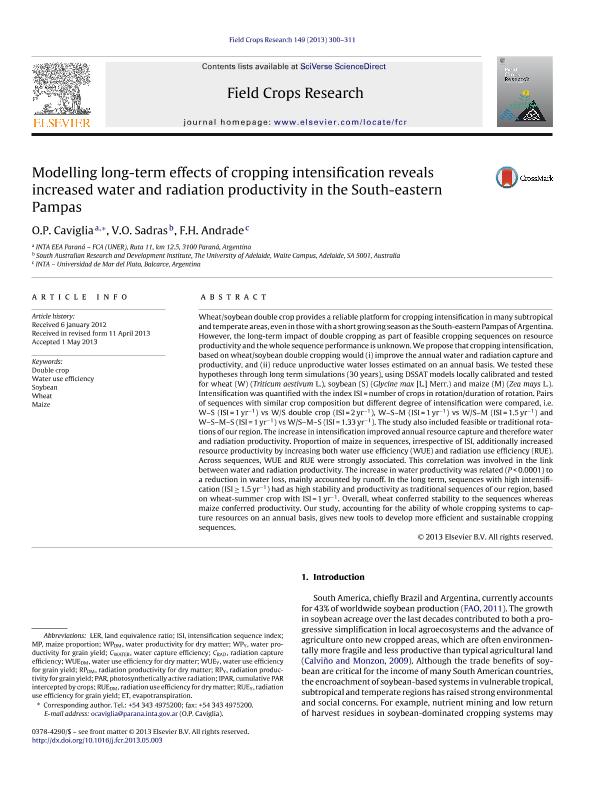Artículo
Modelling long-term effects of cropping intensification reveals increased water and radiation productivity in the south-eastern Pampas
Fecha de publicación:
01/08/2013
Editorial:
Elsevier
Revista:
Field Crops Research
ISSN:
0378-4290
Idioma:
Inglés
Tipo de recurso:
Artículo publicado
Clasificación temática:
Resumen
Wheat/soybean double crop provides a reliable platform for cropping intensification in many subtropical and temperate areas, even in those with a short growing season as the South-eastern Pampas ofArgentina. However, the long-term impact of double cropping as part of feasible cropping sequences on resource productivity and the whole sequence performance is unknown.We propose that cropping intensification, based on wheat/soybean double cropping would (i) improve the annual water and radiation capture and productivity, and (ii) reduce unproductive water losses estimated on an annual basis. We tested these hypotheses through long term simulations (30 years), using DSSAT models locally calibrated and tested for wheat (W) (Triticum aestivum L.), soybean (S) (Glycine max [L.] Merr.) and maize (M) (Zea mays L.). Intensification was quantified with the index ISI = number of crops in rotation/duration of rotation. Pairs of sequences with similar crop composition but different degree of intensification were compared, i.e. W–S (ISI = 1 yr−1) vs W/S double crop (ISI = 2 yr−1), W–S–M (ISI = 1 yr−1) vs W/S–M (ISI = 1.5 yr−1) and W–S–M–S (ISI = 1 yr−1) vs W/S–M–S (ISI = 1.33 yr−1). The study also included feasible or traditional rotations of our region. The increase in intensification improved annual resource capture and therefore water and radiation productivity. Proportion of maize in sequences, irrespective of ISI, additionally increased resource productivity by increasing both water use efficiency (WUE) and radiation use efficiency (RUE). Across sequences, WUE and RUE were strongly associated. This correlation was involved in the link between water and radiation productivity. The increase in water productivity was related (P < 0.0001) to a reduction in water loss, mainly accounted by runoff. In the long term, sequences with high intensifi- cation (ISI ≥ 1.5 yr−1) had as high stability and productivity as traditional sequences of our region, based on wheat-summer crop with ISI = 1 yr−1. Overall, wheat conferred stability to the sequences whereas maize conferred productivity. Our study, accounting for the ability of whole cropping systems to capture resources on an annual basis, gives new tools to develop more efficient and sustainable cropping sequences.
Archivos asociados
Licencia
Identificadores
Colecciones
Articulos(CCT - MAR DEL PLATA)
Articulos de CTRO.CIENTIFICO TECNOL.CONICET - MAR DEL PLATA
Articulos de CTRO.CIENTIFICO TECNOL.CONICET - MAR DEL PLATA
Articulos(SEDE CENTRAL)
Articulos de SEDE CENTRAL
Articulos de SEDE CENTRAL
Citación
Caviglia, Octavio Pedro; Sadras, Victor Oscar; Andrade, Fernando Héctor; Modelling long-term effects of cropping intensification reveals increased water and radiation productivity in the south-eastern Pampas; Elsevier; Field Crops Research; 149; 1-8-2013; 300-311
Compartir
Altmétricas




